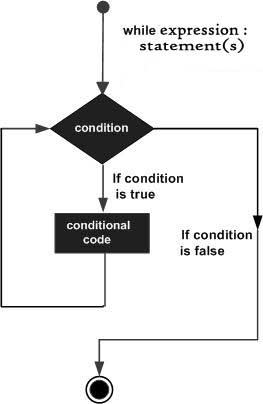Python3 while循環語句
Python編程語言中的 while 循環語句只要給定條件爲真,則會重複執行的目標聲明或語句。
語法
Python編程語言的 while循環的語法 -
while expression:
statement(s)
在這裏,語句(statement**(s))可以是單個語句或均勻縮進語句塊。條件(**condition)可以是表達式,以及任何非零值時爲真。當條件爲真時循環迭代。
當條件爲false,則程序控制流會進到緊接在循環之後的行。
在Python中,所有編程結構後相同數量的字符空格的縮進語句被認爲是一個單一代碼塊的一部分。Python使用縮進作爲分組語句的方法。
流程圖

在這裏,while循環的關鍵點是循環可能永遠不會運行。當條件測試,結果是false,將跳過循環體並執行while循環之後的第一個語句。
示例
#!/usr/bin/python3
count = 0
while (count < 9):
print ('The count is:', count)
count = count + 1
print ("Good bye!")
當執行上面的代碼,它產生以下結果 -
The count is: 0
The count is: 1
The count is: 2
The count is: 3
The count is: 4
The count is: 5
The count is: 6
The count is: 7
The count is: 8
Good bye!
塊在這裏,其中包括打印和增量語句,重複執行直到計數(count)不再小於9。每次迭代,將顯示索引計數(count)的當前值和然後count 加1。
無限循環
如果條件永遠不會變爲FALSE,一個循環就會變成無限循環。使用while循環時,有可能永遠不會解析爲FALSE值時而導致無限循環,所以必須謹慎使用。導致無法結束一個循環。這種循環被稱爲一個無限循環。
服務器需要連續運行,以便客戶端程序可以在有需要通信時與服務器端通信,所以無限循環在客戶機/服務器編程有用。
#!/usr/bin/python3
var = 1
while var == 1 : # This constructs an infinite loop
num = int(input("Enter a number :"))
print ("You entered: ", num)
print ("Good bye!")
當執行上面的代碼,它產生以下結果 -
Enter a number :20
You entered: 20
Enter a number :29
You entered: 29
Enter a number :3
You entered: 3
Enter a number :11
You entered: 11
Enter a number :22
You entered: 22
Enter a number :Traceback (most recent call last):
File "examples\test.py", line 5, in
num = int(input("Enter a number :"))
KeyboardInterrupt
上面的例子中執行進入了一個無限循環,你需要使用CTRL+C才能退出程序。
循環使用else語句
Python支持循環語句相關的else語句。
如果else語句在一個for循環中使用,當循環已經完成(用盡時)迭代列表執行else語句。
如果else語句用在while循環中,當條件變爲 false,則執行 else 語句。
下面的例子說明了,只要它小於5,while語句打印這些數值,否則else語句被執行。
#!/usr/bin/python3
count = 0
while count < 5:
print (count, " is less than 5")
count = count + 1
else:
print (count, " is not less than 5")
當執行上面的代碼,它產生以下結果 -
0 is less than 5
1 is less than 5
2 is less than 5
3 is less than 5
4 is less than 5
5 is not less than 5
單套件聲明
類似於if語句的語法,如果while子句僅由單個語句組成, 它可以被放置在與while 同行整個標題。
這裏是一個單行的 while 子句的語法和例子 -
#!/usr/bin/python3
flag = 1
while (flag): print ('Given flag is really true!')
print ("Good bye!")
上面的例子中進入無限循環,需要按 Ctrl+C 鍵才能退出。